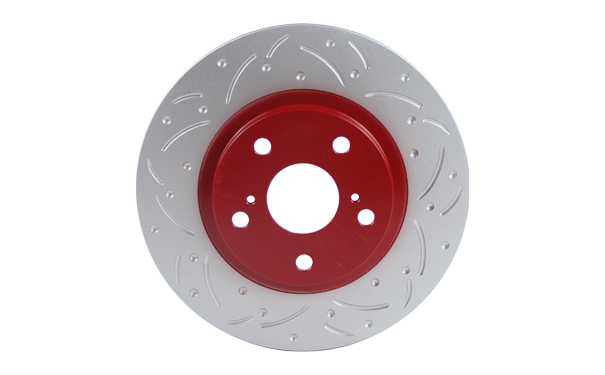As a key component in the automotive braking system, the material of the brake disc directly affects the braking performance, durability, thermal management, and overall driving experience. The common brake disc materials on the market currently include cast iron, carbon ceramics, composite materials, etc. There are significant differences in performance, cost, and applicable scenarios among brake discs made of different materials. The following is a detailed analysis of several common brake disc materials:
1. Cast iron brake discs are widely used brake disc materials, especially in ordinary household and commercial vehicles. Cast iron material has the following characteristics:
Advantages: - Low cost: Cast iron material has a low price, mature manufacturing technology, and is suitable for large-scale production, making it the choice for most economical vehicles. -Good wear resistance: Cast iron brake discs have high hardness and wear resistance, and can withstand frequent braking during daily driving. -Good thermal conductivity: Cast iron has moderate thermal conductivity and can effectively dissipate heat during braking, avoiding overheating of the braking system. -Simple manufacturing process: The manufacturing process of cast iron brake discs is relatively simple, easy to process and shape.
Disadvantages: - Heavy Weight: The high density of cast iron material results in a heavy brake disc, increasing the unsprung mass of the vehicle and affecting handling and fuel economy. -Easy to rust: Cast iron materials are easily affected by humid environments and are prone to rust when exposed to air for a long time, especially in rainy or humid areas. -Thermal attenuation problem: Under extreme driving conditions (such as prolonged intense driving or frequent braking), cast iron brake discs may experience thermal attenuation, leading to a decrease in braking performance.
Applicable scenarios: Cast iron brake discs are suitable for daily driving and ordinary road conditions, especially widely used in economy vehicles and commercial vehicles.
2. Carbon ceramic brake discs are standard materials for high-performance vehicles and luxury sports cars, with excellent performance but high cost. Its characteristics are as follows:
Advantages: - Lightweight: The density of carbon ceramic material is much lower than that of cast iron, which can significantly reduce the weight of brake discs, lower the unsprung mass of vehicles, and improve handling and acceleration performance. -Excellent high temperature resistance: Carbon ceramic brake discs can withstand extremely high temperatures (usually exceeding 1000 ° C) and maintain stable braking performance even under extreme driving conditions, with almost no thermal decay. -Excellent wear resistance: The wear resistance of carbon ceramic material far exceeds that of cast iron, with a longer service life, usually several times that of cast iron brake discs. -Strong corrosion resistance: Carbon ceramic material is not easy to rust and can adapt to various harsh environments.
Disadvantages: - High cost: The manufacturing process of carbon ceramic brake discs is complex and the material cost is high, usually only used for high-end car models or high-performance sports cars. -Poor low-temperature performance: In low-temperature environments, the braking effect of carbon ceramic brake discs may not be as good as cast iron brake discs, requiring a certain amount of preheating time to achieve performance. -High brittleness: Carbon ceramic materials are relatively fragile and may fracture when subjected to strong impacts.
Applicable scenarios: Carbon ceramic brake discs are suitable for high-performance sports cars, luxury cars, and track driving scenarios that require extremely high braking performance.

3. Composite brake discs Composite brake discs are a newly emerging material that combines the advantages of multiple materials to balance performance and cost. Its characteristics are as follows:
Advantages: - Lightweight: Composite brake discs are usually lighter than cast iron brake discs, which helps reduce vehicle weight, improve fuel economy and handling. -Good high temperature resistance: Composite materials can withstand high temperatures and perform well under intense driving conditions. -Strong corrosion resistance: Composite materials are not easy to rust and are suitable for use in humid or rainy environments. -Environmental friendliness: Some composite brake discs are made of recyclable materials, making them more environmentally friendly.
Disadvantages: - High cost: Although cheaper than carbon ceramic brake discs, the cost of composite brake discs is still higher than that of cast iron brake discs. -Complex manufacturing process: The manufacturing process of composite materials is relatively complex, and the production difficulty is high. -Performance stability needs to be improved: Compared with carbon ceramic brake discs, composite brake discs may have slightly inferior performance under extreme conditions.
Applicable scenarios: Composite brake discs are suitable for mid to high end car models and scenarios that require certain environmental protection and performance.
4. In addition to the three mainstream materials mentioned above, there are also some relatively niche brake disc materials, such as aluminum alloy, stainless steel, etc. These materials are typically used for specific scenes or special needs:
-Aluminum alloy brake discs: lightweight, good heat dissipation performance, but low wear resistance and strength, usually used for motorcycles or light vehicles. -Stainless steel brake discs: They have strong corrosion resistance and are suitable for use in humid or rainy environments, but their cost is higher and their heat dissipation performance is not as good as cast iron.
Different materials of brake discs have their own advantages and disadvantages, and the selection should be balanced based on the vehicle type, driving needs, and budget: - Cast iron brake discs: economical and suitable for daily driving. -Carbon ceramic brake discs: Excellent performance, suitable for high-performance vehicles and track driving. -Composite brake discs: balance performance and cost, suitable for mid to high end car models.
No matter which material of brake disc is chosen, regular inspection and maintenance are key to ensuring the safety and reliability of the braking system.
手机:13964587298 / 18354519598
在线QQ:381214835
电话:0535-2836718
E-mail:381214835@qq.com
地址:莱州市土山镇工业园
